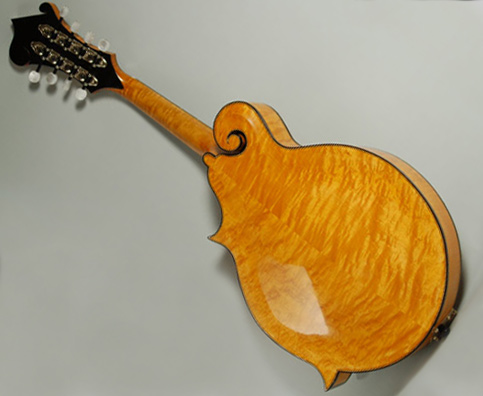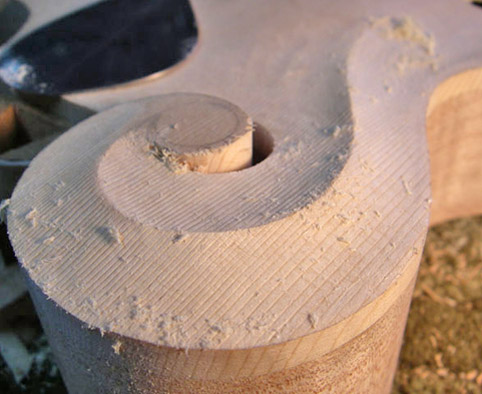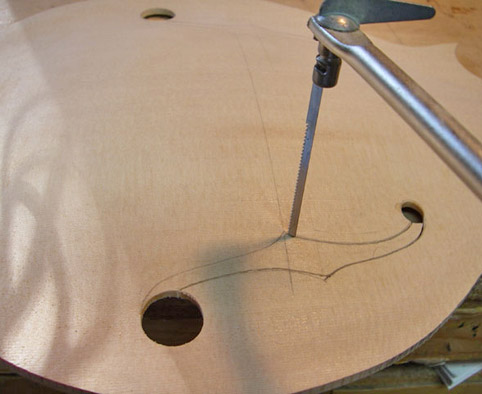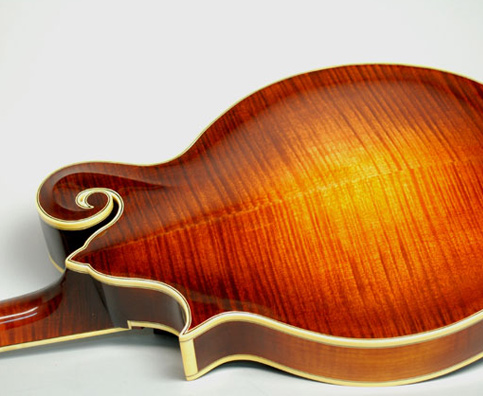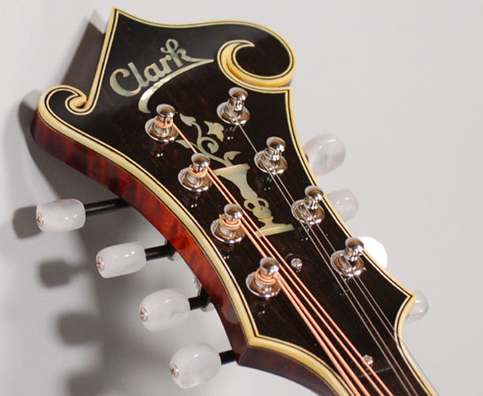
Pick up one of Austin Clark’s exquisite mandolins, turn it over in your hands and play a few notes, and you may be convinced that this is the product of a man who was destined from birth to build these fine musical instruments. The truth, though, is entirely different. The fact that Austin is now making a name for himself as a top-flight mandolin maker seems to have come about as much due to serendipity as anything else.
“I graduated high school wanting to study graphic design,”Austin told me this past summer, “because I enjoyed art classes. I had been working as a cook during high school, so after spending one year in college, I moved to Kansas City to attend a culinary school. There I started a two-year apprenticeship at the Ritz Carlton, then moved to Salt Lake City in 1989 with the idea of working at resorts and being a ski bum. Unfortunately, I ended up working a lot more than skiing. At the time I was a sous chef, which is more or less the manager of the kitchen. I worked at a lot of different hotels and resorts, then moved to Boise, Idaho in ’99 and went to work at a local ski resort as executive chef. That meant I had more regular hours and consequently, more time for hobbies, which included skiing, kayaking and mountain biking.
“Throughout my life, I dabbled with playing a number of musical instruments, including trumpet, French horn, piano and guitar. My wife owned a mandolin, and I decided to try to build one even though I had never done any woodworking before. I started with a Stew Mac kit in 2001 and assembled it, but was rather disappointed not only in how it came out, but also because it required little more than assembly. As soon as I finished it, I started building one from scratch.
“At that point, I had both leisure time and some discretionary income, so I started buying woodworking tools, though more hand tools than power tools. Even today my power tools consist of only a band saw, oscillating spindle sander, drill press, drum sander and router table. I have no table saw, jointer or planer. All my joinery is done with hand tools.
“I was able to sell even my first mandolin, though looking back at it now, it was rather an embarrassment. It played OK, but I did not really know what I was doing. I was shooting in the dark; I had no one to talk to or learn from, and made a lot of mistakes. As a result, I got very good at repair. Along the way, I managed to teach myself and got better and better.
“The real turning point came when I started taking beauty shots of my work. At that point, my objective was to get the work done, and I would often overlook things. Seeing the finished process in photos gave me feedback about just how good, or bad, my work was, at least visually. At the same time, I was learning to refine the sound to create what I wanted to achieve.
“Once I started, I found I really liked building instruments. I started selling them and, in turn, started getting a reputation, but had not done any marketing. Eventually the work started to take over, and I found myself working two full-time jobs; one as a chef, then after hours as a luthier, a person who makes or repairs stringed instruments. At the end of 2007, with a one-year waiting list, I finally quit working as a chef to devote all my time to mandolins.
“These days, I build about 25 instruments per year, working entirely alone, and it is blissful. My mandolins fall into three basic models with lots of options on each, from binding, inlay and other ornamentation schemes to finish and color choices. In terms of finishing, I offer both lacquer and French polish.
“Philosophically, I see a lot similarities between cooking and lutherie. They are both artistic, both have elements beyond the art critical to the product (sound with instruments, taste and smell with food), both require good management of your workflow and environment, and both demand perfection. In part, the demand comes because there’s so much good work out there now that the bar is set really high. However, I also have high expectations of myself, and so do my customers. They are paying anywhere from $2,200 to $5,200 for my instruments and deserve to expect quality.
“I feel really fortunate that circumstances have worked out in such a way as to allow me to do something I really love to do, yet never expected to be doing in my life. It has taken me more toward the art that I was initially interested in as a teenager than cooking ever did. In a sense, my work building instruments completes a circle that started in high school with a love of art.
“As for cooking, I will never miss that, as I am the primary cook in my household. Overall, my stress level has been reduced a hundredfold. Done professionally, building mandolins is vastly more relaxing than cooking. It’s meditative, yet still provides the logistical challenges of running a kitchen. My wife jokes that this is the newer, happier me.”
“So,” I asked Austin, “now for the big question. Do you play mandolin as well?”
“Though I do play mandolin,” he responded, “I don’t play well. Part of my reason for building is to mitigate the fact that I don’t play all that well. This way, I routinely get to hear really good players making music with my instruments.”

